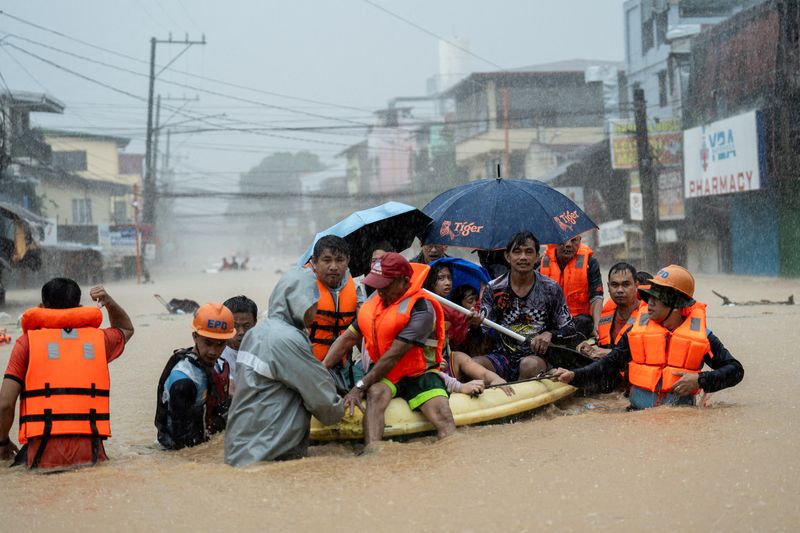Is climate change making tropical storms more frequent? Scientists say it’s unclear

By David Stanway
SINGAPORE (Reuters) – An unusual cluster of typhoons in the West Pacific and a series of powerful hurricanes in the Atlantic are raising questions about the impact that climate change is having on tropical storms across the globe.
As nations thrashed out the details of a new climate financing package at COP29 talks in Azerbaijan, the Philippines was hit by its sixth deadly typhoon in a month while the United States was recovering from two devastating hurricanes.
Scientists say it remains unclear how much climate change is reshaping the storm season, or if it is responsible for the rare appearance of four tropical cyclones at the same time in the West Pacific – the first time this has happened in November since 1961.
Higher sea surface temperatures speed up evaporation and provide additional “fuel” for tropical cyclones, boosting rainfall and wind speeds, they say.
And the latest assessment by the Intergovernmental Panel on Climate Change (IPCC), published in 2023, expressed “high confidence” global warming would make storms more intense.
The Philippines’ latest supertyphoon Man-Yi landed on Saturday, forcing the evacuation of hundreds of thousands of residents. At least eight people died on Monday, adding to a death toll of more than 160 since October.
“It is rare to see a cluster of four tropical cyclones in the western north Pacific at the same time,” said Feng Xiangbo, a tropical storm researcher at Britain’s University of Reading.
“(But) blaming climate change … for this unprecedented event this week is not straightforward,” he added.
Evidence suggests that while climate change is increasing storm intensity, it has also reduced their frequency, especially during what is typically the late season from October to November, Feng said.
This year, atmospheric waves that have recently been active near the equator could be an alternative explanation for the unusual uptick, Feng said, but their relationship with climate change is unclear.
The belt of high pressure known as the sub-tropical ridge, part of the global atmospheric circulation system, has been stronger and stretched further north and west than usual, according to Choy Chun Win, Senior Scientific Officer at the Hong Kong Observatory.
The ridge could have steered the storms in a westerly direction, diverting them away from cooler waters and wind shears, which would normally weaken them, providing an explanation why four could coexist, he said.
“However, more research is required to assess the contribution of climate change to the chance occurrence of the multiple tropical cyclones and the longer tropical cyclone season,” he added.
Ben Clarke, weather researcher with London’s Grantham Institute on Climate Change and Environment, said it “would make sense” that rising ocean temperatures would extend the typhoon season, but the evidence is not conclusive.
“There has been a clear recent increase in the number of tropical cyclones affecting the Philippines in its less active season from approximately December to February, but this doesn’t tell us much about … June-November,” he said.
STRONGER HURRICANES
In an analysis published on Wednesday, U.S. weather researchers Climate Central said Atlantic hurricanes have intensified significantly this year as a result of record-breaking ocean warming.
Since 2019, warmer temperatures have driven average wind speeds up by 18 miles per hour (29 kph) and pushed three hurricanes into the highest Category 5, the study said.
The two deadly Category 5 hurricanes known as Helene and Milton, which hit Florida in September and October respectively, would have been unlikely without climate change, it said.
Research is still ongoing on whether tropical cyclones are becoming more frequent, but there is high scientific confidence that warmer sea temperatures are driving up rainfall and causing higher storm surges, said Daniel Gilford, Climate Central’s lead hurricane researcher.
“While other factors contribute to each storm’s strength, the impacts of elevated sea surface temperatures are prominent and significant,” he said.
“In the Atlantic, more than 80% of storms since 2019 were clearly influenced by warm ocean temperatures caused by carbon pollution.”
(Reporting by David Stanway; Editing by Sonali Paul)